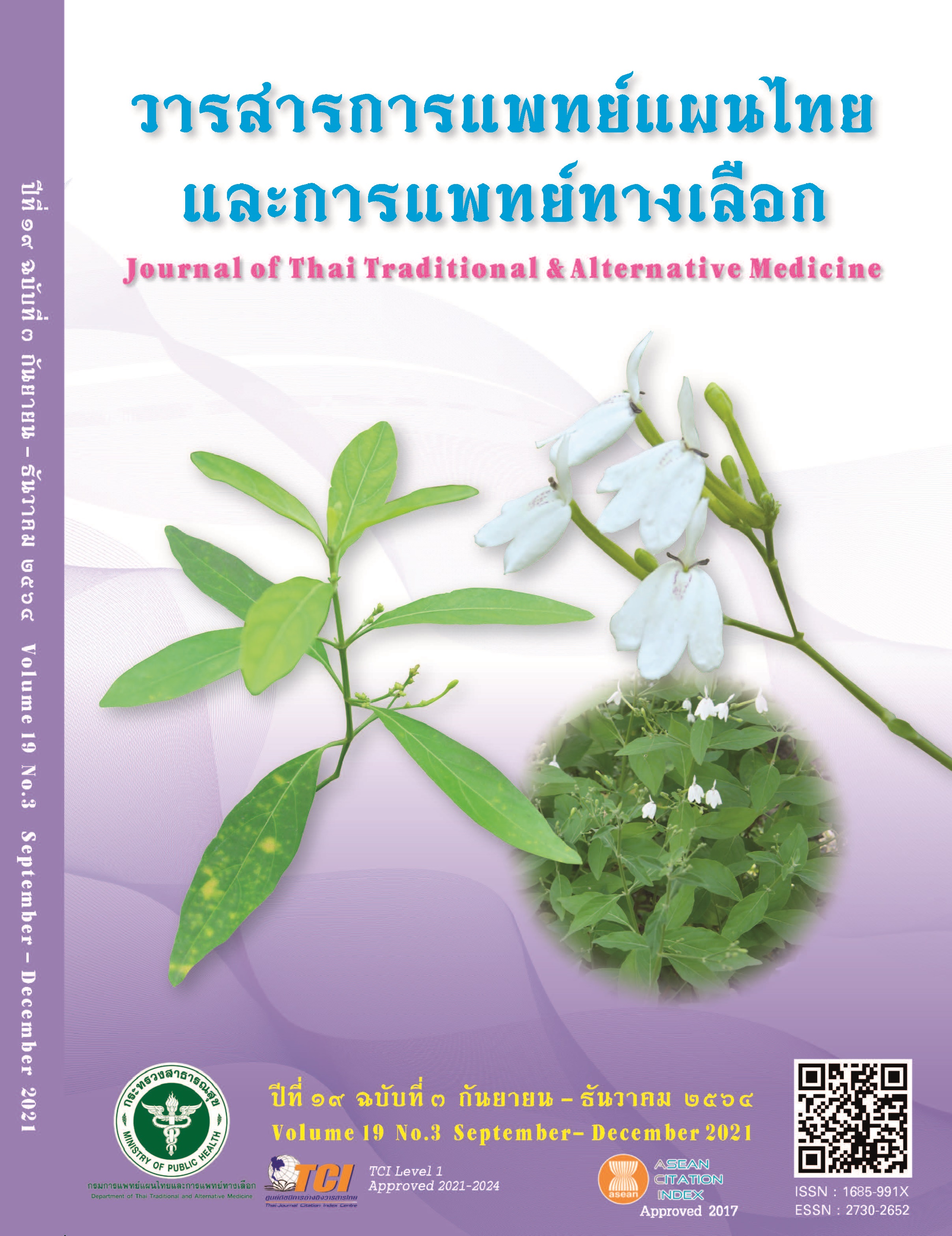Method Development and Validation for Quantification of Rhinacanthin-C in Rhinacanthus nasutus Roots
Main Article Content
Abstract
The quantity of a chemical constituent in a herb is a good indicator for quality assessment as the constituent can indicate that the herb has enough active component to ensure its efficacy, or whether it is toxic. Therefore, the researchers developed an analytical method for quantifying the amount of rhinacanthin-C, which is a major chemical constituent found in the roots of Rhinacanthus nasutus (thongphanchang in Thai) by using the High-Performance Liquid Chromatography (HPLC) technique. This method was validated for its specificity, linearity, precision and accuracy. The method could separate rhinacanthin-C from other chemical components in the sample of R. nasutus roots. The validation of this analytical method showed that the linearity was between 0.04 and 0.20 mg/mL and the correlation coefficient value was 0.9995. The precision and intermediate precision tests showed %RSD of 0.39% and 1.39%, respectively. The accuracy test showed %recovery at low, medium and high concentration levels of 97.6%, 97.5% and 97.4%, respectively. The results suggest that the developed method can be used to quantify the amount of rhinacanthin-C in raw R. nasutus roots.
Article Details

This work is licensed under a Creative Commons Attribution-NonCommercial-NoDerivatives 4.0 International License.
References
References
Tunsaringkarn T, Palanuvej C, Issaravanich S, Vipunngeun N, Rungsiyothin A, Chuthaputti A, Ruangrungsi N. Quality assessment of Rhinacanthus nasutus. Journal of Health Research. 2009;23(3):111-5.
Pingboonrod S. Foreign plants in Thailand. Department of Sciences; 1950. 321. (in Thai)
Wu T, Hsu H, Wu P, Leu Y, Chan Y, Chern C, Yeh M, Tien H. Naphtoquinone esters from the root of Rhinacanthus nasutus. Chemical and Pharmaceutical Bulletin. 1998;46(3):413-8.
Puttarak P, Charoonratana T, Panichayupakaranant P. Antimicrobial activity and stability of rhinacanthinsrich Rhinacanthus nasutus extract. Phytomedicine. 2010;17(5):323-7.
Sendl A, Chen J, Jolad S, Stoddart C, Rozhon E, Kernan M. Two new Naphthoquinones with antiviral activity from Rhinacanthus nasutus. Journal of Natural Products. 1996;59:808-11.
Shah MA, Khalil R, Ul-Haq Z, Panichayupakaranant P. α-Glucosidase inhibitory effect of rhinacanthins-rich extract from Rhinacanthus nasutus leaf and synergistic effect in combination with acarbose. Journal of Functional Foods. 2017;36:325-31.
Panichayupakaranant P, Charoonratana T, Sirikatitham A. RP-HPLC analysis of rhinacanthins in Rhinacanthus nasutus: validation and application for the preparation of rhinacanthin high-yielding extract. Journal of Chromatographic Science, 2009;47:705-8.
Tewtrakul S, Tansakul P, Panichayupakaranant P. Anti-allergic principles of Rhinacanthus nasutus leaves. Phytomedicine. 2009;16(10):929-34.
Tewtrakul S, Tansakul P, Panichayupakaranant P. Effects of rhinacanthins from Rhinacanthus nasutus on nitric oxide, prostaglandin E2 and tumor necrosis factor-alpha releases using RAW264.7 macrophage cells. Phytomedicine. 2009;16(6-7):581-5.
Ngoc T, Phuong N, Khoi N, Park S, Kwak H, Nhiem N, Trang B, Tai B, Song J, Ko H, Kim S. A new naphthoquinone analogue and antiviral constituents from the root of Rhinacanthus nasutus. Natural Product Research. 2019;33(3):360-6.
Yoosuk S. Standard operating procedure no.2213003 revision no. 2 Method validation of chromatographic method. Nonthaburi: Bureau of Drug and Narcotic, Department of Medical Sciences; 2020:1-18. (in Thai).
ICH expert working group. Stability testing: photostability testing of new drug substances and products Q1B. International Conference on Harmonisation of Technical Requirements for Registration of Pharmaceuticals for Human Use [Internet]. 1996. [cited 2021 Jan 21]; [12 screens]. Available from: https://database.ich.org/sites/default/files/Q1B%20Guideline.pdf


